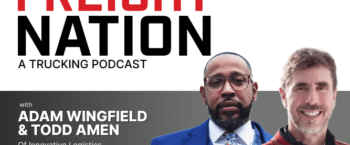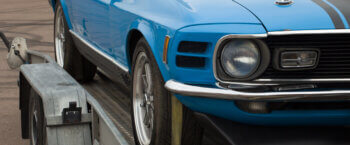What Is Hot Shot Trucking?

What are you waiting for?
Make more money starting now.
Looking to get into trucking without making a big investment? Hot shot trucking might be for you.
We discuss the equipment you need to get started and the earnings you can expect to earn delivering hot shot loads.
What Is Hot Shot Trucking?
Hot shot trucking is the transport of small, time-sensitive LTL loads (less than truckload) within a specific timeframe, usually to a single customer or location. Hot shot loads are typically delivered by medium-duty trucks pulling flatbed trailers. And if those loads are under 10,000 lbs, drivers don’t need a CDL to deliver them.
Most drivers are freelance owner-operators who find their loads on load boards. But company drivers sometimes take on hot shot freight jobs, too.
Hot shot truck drivers usually have experience transporting various load types and have the necessary equipment to do so. They’re attracted to these delivery jobs because they pay decent rates based on experience, especially if a company needs a piece of equipment transported quickly to avoid a loss in productivity.
For example, if a builder needs a piece of construction equipment delivered to a job to keep a project on time, they might post it on a load board as a hot shot load to get it delivered ASAP at a higher rate.
Hot shot trucking differs from expedited shipping, which usually involves a motor carrier keeping vans, tractor-trailers, or even pickup trucks on standby to get the job done. This makes hot shot trucking a great opportunity for owner-operators looking for their next load or to make some extra money on the side.
Truck Types Used for Hot Shot Hauls
A hot shot driver can use various truck types, but the most common is a one-ton pickup truck classified as “medium-duty” by the Federal Highway Administration (FHWA). These trucks are generally classified as non-commercial vehicles, but you can use them for hot shot trucking if you have your operating authority, a USDOT number (if you’re hauling over state lines), liability insurance, and proof that you have your own business.
Hot shot trucks typically fall under Class 3, 4, or 5. They can be pickups, flatbeds, box trucks, or even delivery vans or small buses.
Class 3
Class 3 medium-duty trucks have a weight limit of 10,001-14,000 lbs and a minimum of six tires. Some of the most common types are the Chevrolet Silverado 3500, the GMC Sierra 3500, the Ford F-350, and the Ram 3500.
Class 4
Class 4 medium-duty trucks have a weight limit of 14,001-16,000 lbs. The Chevrolet Silverado 4500, the Ford F-450, and the Ram 4500 are common examples. These are heavier trucks, but they’re still classified as non-commercial. If you anticipate hauling larger loads, you may want to invest in a Class 4 pickup truck.
Class 5
Class 5 medium-duty trucks have a weight limit of 16,001-19,500 lbs. Common models include the Chevrolet Silverado 5500, the Ford F-550, and the Ram 5500. Class 5 is also where some of the lightest commercial trucks are categorized. The Kenworth T170, Peterbilt 325, and International TerraStar fall into this category.
Trailer Types Used for Hot Shot Shipping
Choosing a trailer is a big decision and depends mostly on the pickup truck you’re using and the types of loads you intend to haul.
Bumper pull trailers
These trailers are generally shorter and less expensive than other trailers, and they’re well suited to smaller loads. They’re easy to use and popular with drivers new to hot shot truck driving.
The one drawback is that these trailers don’t have much capacity and can sway or become unstable if the combined load and trailer weight exceeds 10,000 lbs.
Gooseneck trailers
Loved for their stability, gooseneck trailers have a tighter turn radius than bumper pull trailers. They can usually carry larger, heavier loads, but they may require you to invest in a special hitching system. If you’re dedicated to hot shot trucking, you may want to invest in a gooseneck trailer over a bumper pull trailer.
Tilt deck trailers
These trailers tilt at an angle so you can load heavy cargo more easily. Then you can return them to a flat position for transport. This functionality is possible thanks to a hydraulics system that requires filter and oil changes, so maintenance costs for this type of trailer might be slightly higher.
Lowboy trailers
Lowboy trailers have a low center of gravity, ideal for the heaviest loads. They lay flat on the ground when they’re detached from your truck. If you need to transport a tall load, a lowboy flatbed trailer can help you clear certain height restrictions.
The one drawback to lowboy trailers is the minimal deck space. You might be able to take a heavier load, but you won’t be able to haul as much material at a time.
Dovetail trailers
If you’re hauling cars or other equipment with wheels, a dovetail trailer is affordable — and easy to resell when you no longer need it.
One drawback is that they hang low at the back of the trailer, so it’s difficult to haul anything up a steep incline without dragging.
Pros and Cons of Hot Shot Trucking
Hot shot trucking can be a great side gig with the right equipment, even if you work a regular job. That said, it isn’t for everyone — it has pros and cons, both as a career and a lifestyle.
The pros
It doesn’t take a large investment to get started in hot shot trucking. Class 3 trucks are much less expensive than class 8 long-haul trucks, and they’re cheaper to insure. The low startup costs are attractive to many drivers who want to strike out on their own but don’t want to haul large loads.
Hot shot jobs require tight turnarounds, so you can usually get premium rates for each job. You decide which loads to take and when you drive. You can even set your own rates and don’t have to worry as much about downtime.
Hot shot trucking also gives you the opportunity to haul interesting loads on almost every job. Many drivers enjoy the challenge of the job and take pride in helping customers on a tight deadline.
The cons
Hot shot trucking pays per mile, so you can’t expect a regular owner-operator salary. You may also need to be ready to take on loads at a moment’s notice, and you will spend some time deadheading to get each job done.
Hot shot trucking requires you to take the initiative to build a network and find a business for yourself. You are also expected to comply with most of the same regulations as other carriers, including insurance laws, hours of service (HOS) logging, and drug and alcohol testing.
How Much Do Hot Shot Drivers Make?
Hot shot drivers can earn as much as $100,000 gross income per year, but the median yearly salary is about $45,000.
The amount you can make as a hot shot driver depends on several factors:
- The number of hours you work
- The equipment you’re using to haul loads
- The region in which you operate
- The number of loads available
- The types of loads you carry
- Your years of experience
- Fuel prices
- Your rates
- Your costs to do business
How Do You Find Hot Shot Jobs and Loads
If you want to be a hot shot driver, you can find loads to carry through your network, but most hot shot drivers turn to load boards.
Some new hot shot drivers choose free load boards to avoid a monthly fee. But you get what you pay for. Free load boards aren’t always up-to-date or reliable, and they likely don’t have enough high-paying loads to keep you busy.
When you search for loads on a load board like Truckstop, you get valuable rate information right at your fingertips and a high volume of well-paying loads. More importantly, all the brokers on Truckstop are vetted and approved before they can post, so you can be confident you’re getting the best loads from the most trustworthy sources.
Searching for a load
After logging in to Truckstop, you’ll see the main dashboard and the option to go to the load board. Once there, click on “Searching” in the menu bar and click on “Loads” to start a new search for hot shot loads.
You can search for loads by origin and destination, but pay close attention to your trailer selection. Here, you can select “Hot Shot” as your equipment option to ensure you’re getting the right loads. Be sure to enter your maximum weight based on your vehicle.
On your load results grid, you’ll see all the key information about each load on the line. Click on the load to open the load summary card to get the most important information. You’ll find more information about the posting company and their contact details here. If you like what you see, contact them to start negotiating, agree to a rate, and start hauling.
You can choose to be notified when new loads are posted that meet your requirements by using Load Alert Notifications. This feature helps put you first in line for the best hauls that match your preferences.
Setting the Right Rates
Setting an average rate of $1.50 per mile is a good goal if you’re just starting out. Depending on your driving costs and what you’re willing to work for, you could go as low as $1. Eventually, you’ll want to set your rates in the $2-$3 range.
Before you start hot shot driving, itemize your driving costs. These typically include:
- Fuel costs
- Factoring/dispatch services
- Maintenance
- Insurance
Ideally, you’ll be able to determine your cost per driving mile. Subtract this rate from your earned-per-mile rate to know how much you can put in the bank.
To find the best hot shot rates, search for loads that meet your specifications on Truckstop. Shoot for at least two to three of the best-paying loads to start and go from there.
You can also search for loads that will cover deadheads. For example, if you’re based in Dallas, and you’re hauling to New Orleans, it only makes sense to pick up a load in New Orleans to haul back home. This way, you aren’t wasting time or miles without pay.
Logistics and Requirements for Hot Shot Trucking
Getting the hot shot truck and trailer you need is important. First, there’s some paperwork to take care of before you can start hot shot trucking.
Even if you’re driving a “civilian” truck, you must register it commercially. If your vehicle isn’t licensed properly, you could be fined.
As an owner-operator, you’re in charge of your driving logs. Use these to mark timing, distance, and the weight of your hauls under hours of service (HOS) regulations. If hauling over state lines, stay aware of each state’s regulations and how to document hour hauls for interstate transport. Using the right electronic logging device (ELD) can help you track your hours and optimize your routes for efficiency.
Before you get into the business, do the following:
- Get your commercial driver’s license (CDL) if you want to haul loads exceeding 10,000 lbs.
- Get properly insured (liability, physical damage, cargo).
- Get a USDOT number and MC number (for interstate commerce and regulated commodities).
- Understand HOS regulations.
- Know how to secure loads properly.
- Comply with brake standards and regulations.
- Find the right ELD.
To get a U.S. Department of Transportation number, apply using FMCSA’s Unified Registration System. FMCSA also lists the insurance requirements you need to operate.
A CDL is not always required for hot shot trucking, but it’s highly recommended. If your trailer has a gross vehicle weight rating (GVWR) of 10,001 lbs. or more and the gross combined weight rating (GCWR) of the truck and trailer is 26,001 lbs. or more, a CDL is required.
You can get a Class A CDL — sometimes called the “universal” CDL — through your state. Start with the CDL manual. From there, you’ll need to get a commercial learner’s permit (CLP), attend a CDL program, pass a knowledge exam, and pass a driving test. You’ll also need to undergo a medical exam to ensure you’re safe to drive.
Ready to Find Your Next Hot Shot Load?
Truckstop provides the best load board for finding hot shot loads anywhere.

Find out how our platform gives you the visibility you need to get more done.
Get helpful content delivered to your inbox.
Schedule a demo.
Find out how our platform gives you the visibility you need to get more done.





